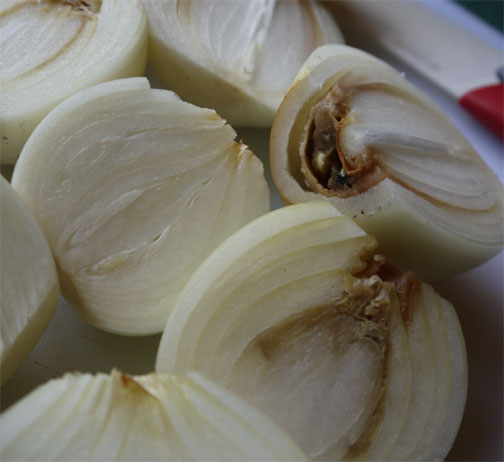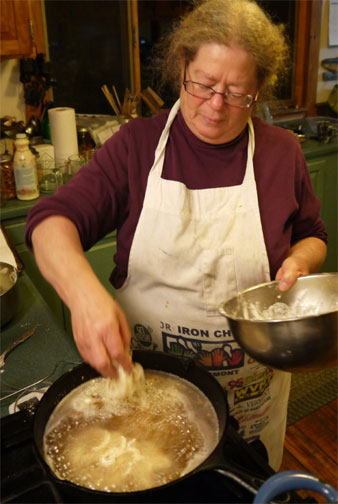 Turns out 50 pounds of onions will probably only last through January
Turns out 50 pounds of onions will probably only last through January
I bought 50 pounds of unsorted onions from Elmer Farm, my CSA farmers this fall. I figured unsorted meant that the onions varied in size, but I didn’t know that they would also vary in likelihood of storing well.
 Some of the onions didn't cure properly.
Some of the onions didn't cure properly.
Some of the onions had soft necks where the leaves had not fully dried. Each layer of an onion is actually a leaf, and some leaves dry better than others—no matter how well they are handled post harvest. So before storing, I had to sort the onions, setting aside those with thick and/or soft necks for using immediately. Turns out, about 15 pounds were destined to be used quickly. Any by using quickly, I mean, discarding any slimy brown layers, but utilizing the rest of the onion.
 I could feel the onions with soft necks, alerting me to the fact they wouldn't store well.
I could feel the onions with soft necks, alerting me to the fact they wouldn't store well.
You’d think that would be a daunting situation, but it wasn’t. First, 6 pounds or so went into making Rosemary Onion Confit (see March Madness 2012). Some went into the dehydrator, some went into a beef and onion stir-fry with black bean sauce, some went into onion soup. And the rest were fried—not something I recommend doing but often, what a wonderful once-a-year treat!
About the stir-fry, I followed my basic recipe for a stir-fry (see Serving Up the Harvest, pages 35-35), using beef and 8 cups of slivered onions, substituting black bean sauce and 1 tablespoon chopped fermented black beans for the oyster sauce, and omitting the broth and cornstarch. When I returned the stir-fried beef to the wok with the seared onions, I added 6 sliced scallions. The only trick with an onion-based stir-fry is to use a really, really hot wok and get a good sear on the onions.
 Beef and Onion Stir-Fry with Black Bean Sauce
Beef and Onion Stir-Fry with Black Bean Sauce
For the onion soup, trust me, you don’t need a recipe. Also, you don’t need to serve it with a cheese layer on top—you can melt cheese on toast under the broiler and then ladle the soup on top. It is much easier to eat that way. To make onion soup, just slice several pounds of onions; you’ll want 8 to 12 cups of sliced onions. Then pour beef broth on top—could be homemade from roasted soup bones, could be from bouillon, or canned—using enough to cover the onions, 8 to 12 cups, and simmer for about 30 minutes. Season with soy sauce, which has that umami quality and darkens the color of the broth nicely, and pepper.
 Ladling onion soup onto cheese toasts.
Ladling onion soup onto cheese toasts.
And finally, the fried onion rings. I went for a simple seasoned flour for a coating, dipping the onions first in buttermilk, then in flour, then into the hot onion in batches until browned. They turned out great—crunchy, sweet, salty—and maybe just a little too good. So as with all good seasonal foods, enjoy fried onions as a celebration of the harvest, and don’t worry if your onions haven’t cured as well as you would have liked.
 Deep frying onions.
Deep frying onions.
Oh, and where are all those onions stored? In an unheated upstairs closet. I don’t know what people do who have heat in the upstairs bedrooms.  An unheated closet is the perfect place to store onions. How do they store their onions? How do they sleep?
An unheated closet is the perfect place to store onions. How do they store their onions? How do they sleep?

